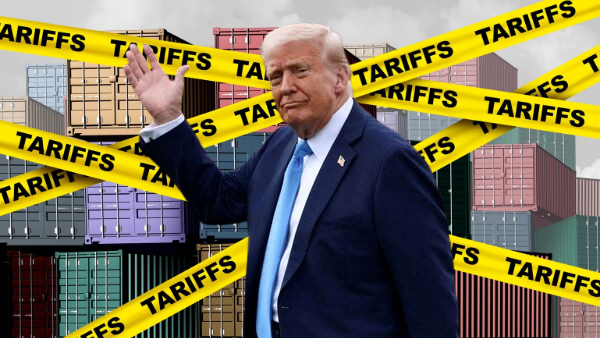
- The Trump Administration’s reciprocal tariffs are not just a trade policy change but a potent inflection point for global economic relations.
- Reciprocal tariffs, at its heart, is designed to use leverage to make trading partners negotiate better terms and have their markets more open.
- India’s economy, which was already grappling with a host of challenges ranging from domestic reforms to global market volatility, now faces a new set of headwinds.
- Reciprocal tariffs might also signal a re-framing of the strong economic relationship that India has with the United States.
The Trump Administration’s so-called “reciprocal tariffs” that come into effect today on 02/04/2024 have sent shockwaves through global trade, with India squarely in their crosshairs. The Trump Administration announced these “reciprocal tariffs” on February 4, 2024, these tariffs, while serving as a clear indication of the administration’s commitment to addressing long-standing trade disparities, evoke urgent consideration of their potential impact not only on India’s economic growth but also on the trajectory of the India-US trade relationship and the strategic pathways available to India in light of this development.
The Rationale Behind Reciprocal Tariffs
Reciprocal tariffs are designed to use leverage to make trading partners negotiate better terms and have their markets more open. But these tariffs, in the case of the Trump Administration, are framed as a direct reaction to perceived trade inequities and an effort to pressure countries like India to re-evaluate their export and import behaviour. Yet, this strategy presents a double-edged sword: it aims to strengthen local industries and rebalance trade deficits, but it also threatens to disrupt established international trade relationships and impose unexpected costs on global production networks.
The Trump administration’s implementation of reciprocal tariffs has sparked significant concerns about potential economic repercussions, including a U.S. recession, a global economic slowdown, and the disruption of the post-World War II trade order. These tariffs, aimed at addressing perceived trade imbalances, could instead trigger unintended consequences that reverberate through both the U.S. and international economies.
Economic Risks and Global Consequences
- Disrupting Global Supply Chains: By increasing the cost of imports, these tariffs could severely disrupt established supply chains, creating bottlenecks in production and forcing companies to either absorb the higher costs or shift operations elsewhere. Given the highly integrated nature of modern trade, these disruptions could have cascading effects across multiple industries.
- Rising Consumer Prices & Inflation: The additional costs from tariffs are often passed on to consumers, leading to higher prices for goods and services. This could exacerbate inflationary pressures in the U.S. economy, reducing consumer purchasing power and potentially slowing economic growth.
- Triggering Retaliatory Tariffs & Trade Wars: Other nations affected by these tariffs are likely to respond with their trade barriers, escalating tensions and provoking full-scale trade wars. Historical precedents, such as the Smoot- Hawley Tariff Act of 1930, suggest that aggressive protectionist policies can contribute to prolonged economic downturns.
- Creating Investment Uncertainty: The unpredictability of trade policies discourages both domestic and foreign investment. Businesses wary of shifting regulations may delay or cut capital expenditures, negatively impacting job creation and long-term economic stability.
- Damaging International Relations & Global Economic Order: Reciprocal tariffs could strain diplomatic ties between the U.S. and its key trading partners, undermining alliances built over decades. The post-war economic framework, which encouraged liberalized trade, could unravel, leading to increased protectionism and reduced international cooperation in areas such as technology, defense, and climate change initiatives.
The unpredictability of trade policies discourages both domestic and foreign investment.
The Risk of a U.S. Recession and Global Slowdown
Financial markets have already reacted negatively to heightened trade tensions. For instance, the S&P 500 experienced a sharp drop, reflecting investor fears of economic instability. Additionally, the OECD has downgraded global growth forecasts, citing trade disputes as a primary risk factor. Economists warn that prolonged tariff conflicts could lead to stagflation, which is a combination of stagnant growth and rising inflation, similar to the economic struggles of the 1970s.
In conclusion, while the Trump administration’s reciprocal tariffs aim to correct trade imbalances, they risk destabilizing the global economy. The potential fallout, ranging from supply chain disruptions and inflation to diplomatic rifts and declining investments, could accelerate a U.S. recession and a broader global slowdown. Whether the U.S. and its trading partners can navigate these choppy waters through diplomatic negotiation or face a prolonged period of economic turbulence remains to be seen.
Implications for India’s Economic Growth
India’s economy, which was already grappling with a host of challenges ranging from domestic reforms to global market volatility, now faces a new set of headwinds. By raising the price of important Indian exports to the United States, the tariffs risk undermining the competitive advantage of sectors such as textiles, pharmaceuticals and engineering goods.
- Increased Costs and Supply Chain Disruptions: The immediate impact has been that the cost of exports has gone up, which would mean a decline in demand for Indian products in the US market. Since global supply chains are integrated, disruptions in any one market can lead to cascading effects on production cycles and pricing strategies in other industries as well.
- Inflationary Pressures: The higher tariffs can be inflationary domestically. With prices of imported intermediate goods increasing, Indian manufacturers may pass those onto consumers, giving a potential to slow consumption and reduce the economic momentum.
- Investment Uncertainty: Uncertainty about trade policy can prevent investment – both domestic and foreign. Investors concerned about a choppy policy environment may postpone or trim capital spending, which in turn can feed back into job creation and economic growth.
These factors contribute to growing fears of a recession and a global slowdown while also threatening the stability of the current international economic framework.
Impact on India-US Trade Relations
Reciprocal tariffs might also signal a re-framing of the strong economic relationship that India has with the United States. As the US continues to be an important market for Indian goods, the tariffs highlight an increasing readiness on behalf of the Trump Administration to impose unilateral adjustments in trade dynamics:
- Bilateral Tensions: The tariffs are going to stoke diplomatic tensions. In the eyes of the Indian government, these tariffs could resemble an exercise of economic coercion, which would lead the Government of India to align its policies to US trade interests at the cost of compromising India’s own strategic interest.
- Negotiation Leverage: On a subtler level, the tariffs may usefully prompt India to new negotiations over trade terms. Through proactive diplomacy, India could have used its large, growing market potential to gain concessions or carve-outs for its most vulnerable sectors.
- Long-term Realignment: If mishandled, these tariffs could hasten a longer run realignment of global trade partnerships. Either nation risks hardening protectionist measures that would hinder future cooperation in technology, defense and climate-change initiatives.
Strategic Response Options for India
In light of the manifold risks posed by reciprocal tariffs, India’s policymakers must pursue a twin track: protect domestic growth while protecting the strategic partnership with the US.
- Diplomatic Engagement: India may launch high-fired trade negotiations with the Trump Administration. This should at least clarify its commitment to trade and mutual economic benefits so that India can negotiate tariff relief or even, as a transitional measure, exemptions from the RCEP.
- Structural Reforms: At this juncture, emphasizing economic reforms, particularly on ease of doing business, developing better regulatory frameworks and investing in infrastructure will surely make India more competitive. A stronger industrial base is more able to absorb external shocks and harness new opportunities.
- Export Diversification: To reduce reliance on the US market, India must broaden its export horizons. This includes:
- Expanding Trade with Asia and Africa: Regional trade Intra-Asia & Africa are promise alternative to the regional trade agreements. With these markets witnessing rapid growth, India’s strong manufacturing and service sectors can explore new opportunities.
- Exploring European and Latin American Markets: Strategic partnerships can also help soften the blow from US tariffs in Europe and Latin America. Diversification of exports would help India offset risks arising from concentrated market access concerns.
- Investing in Value-Added Sectors: Moving up the value chain in its export basket towards advanced manufacturing, digital services and green technologies can create additional streams of revenue and dampen the impact of tariff shocks.
Conclusion
The Trump Administration’s reciprocal tariffs are not just a trade policy change but a potent inflection point for global economic relations. For India, the tariffs represent a direct challenge to its economic growth and could feed into its historic trade frictions with the United States. While the global economic scenario remains turbulent, with early warning signals in the form of failing exports, by undertaking timely diplomatic initiatives; making structural changes while being intentional with coverage; and redirecting focus to non-traditional sectors that allow diversifying export markets; India can not only simply survive in these moving waters but also sail forth with strength.
These tariffs are certainly a weapon of coercion today, as they remind us not only of the heavy-handed negotiations mediated through trade but also of India’s position on the world stage as a nation with an increasingly inward-looking economic strategy. The path best taken will demand prudent navigation, creativity, and a steadfast commitment to long-term national interests.
References:
- Reuters. (2024, February 4). Trump administration imposes reciprocal tariffs on India, sparking global trade tensions. https://www.reuters.com/article/trump-tariffs-india-2024
- Miller, S. (2024, February 4). Trump’s new trade strategy: Reciprocal tariffs and their impact on India-US relations. The New York Times.https://www.nytimes.com/2024/02/04/trump-reciprocal-tariffs-india.html
- Jones, A. (2024, February 4). Reciprocal tariffs take effect as Trump administration targets India, raising questions over economic growth and trade ties. The Washington Post. https://www.washingtonpost.com/2024/02/04/trump-tariffs-india-economic-impact
- Shawn Donnan, Enda Curran and Maeva Cousin (2025, April 1) Trump’s Tariffs Set to Make History and Break a System MAGA Loathes. Bloomberg Economics: https://www.bloomberg.com/news/features/2025-03-31/trump-s-reciprocal-tariffs-risk-us-recession-trade-turmoil
Shashank is a Master’s student in Diplomacy, Law, and Business at O.P. Jindal Global University. He is also a researcher and coordinator at the Center for Global South and the Center for Southeast Asian Studies. His research interests include Southeast Asia, Chinese foreign policy, India’s Act East Policy, and global security dynamics. Views expressed are the author’s own.
